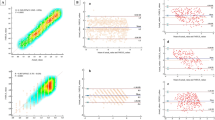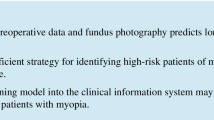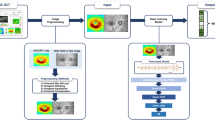Abstract
Recently, fundus photography (FP) is being increasingly used. Corneal curvature is an essential factor in refractive errors and is associated with several pathological corneal conditions. As FP-based examination systems have already been widely distributed, it would be helpful for telemedicine to extract information such as corneal curvature using FP. This study aims to develop a deep learning model based on FP for corneal curvature prediction by categorizing corneas into steep, regular, and flat groups. The EfficientNetB0 architecture with transfer learning was used to learn FP patterns to predict flat, regular, and steep corneas. In validation, the model achieved a multiclass accuracy of 0.727, a Matthews correlation coefficient of 0.519, and an unweighted Cohen’s κ of 0.590. The areas under the receiver operating characteristic curves for binary prediction of flat and steep corneas were 0.863 and 0.848, respectively. The optic nerve and its peripheral areas were the main focus of the model. The developed algorithm shows that FP can potentially be used as an imaging modality to estimate corneal curvature in the post-COVID-19 era, whereby patients may benefit from the detection of abnormal corneal curvatures using FP in the telemedicine setting.
Graphical Abstract












Similar content being viewed by others
Data availability
Sample FP images of corneal curvature groups were deposited into a public repository (https://data.mendeley.com/datasets/bc2jfr7dv9) to validate the study. Data will be made available by the corresponding author upon reasonable request.
References
Varadarajan AV, Poplin R, Blumer K et al (2018) Deep learning for predicting refractive error from retinal fundus images. Invest Ophthalmol Vis Sci 59:2861–2868. https://doi.org/10.1167/iovs.18-23887
Xu L, Wang YX, Guo Y et al (2012) Prevalence and associations of steep cornea/keratoconus in Greater Beijing. The Beijing Eye Study. PLoS One 7:e39313. https://doi.org/10.1371/journal.pone.0039313
Elliott JH, Feman SS, O’Day DM, Garber M (1985) Hereditary sclerocornea. Arch Ophthalmol 103:676–679. https://doi.org/10.1001/archopht.1985.01050050068020
Vanhonsebrouck E, Consejo A, Coucke PJ et al (2021) The corneoscleral shape in Marfan syndrome. Acta Ophthalmol 99:405–410. https://doi.org/10.1111/aos.14636
Mohamed Mostafa E (2015) Effect of flat cornea on visual outcome after LASIK. J Ophthalmol 2015:e794854. https://doi.org/10.1155/2015/794854
Qin Y, Liu L, Mao Y et al (2023) Accuracy of intraocular lens power calculation based on total keratometry in patients with flat and steep corneas. Am J Ophthalmol 247:103–110. https://doi.org/10.1016/j.ajo.2022.11.011
Yoo TK, Ryu IH, Kim JK et al (2022) A deep learning approach for detection of shallow anterior chamber depth based on the hidden features of fundus photographs. Comput Methods Programs Biomed 219:106735. https://doi.org/10.1016/j.cmpb.2022.106735
Gong W, Cheng T, Wang J et al (2022) Role of corneal radius of curvature in early identification of fundus tessellation in children with low myopia. Br J Ophthalmol. https://doi.org/10.1136/bjo-2022-321295
Sommer AC, Blumenthal EZ (2020) Telemedicine in ophthalmology in view of the emerging COVID-19 outbreak. Graefes Arch Clin Exp Ophthalmol 258:2341–2352. https://doi.org/10.1007/s00417-020-04879-2
Parikh D, Armstrong G, Liou V, Husain D (2020) Advances in telemedicine in ophthalmology. Semin Ophthalmol 35:210–215. https://doi.org/10.1080/08820538.2020.1789675
Sunnetci KM, Alkan A (2023) Biphasic majority voting-based comparative COVID-19 diagnosis using chest X-ray images. Expert Syst Appl 216:119430. https://doi.org/10.1016/j.eswa.2022.119430
Sunnetci KM, Kaba E, Beyazal Çeliker F, Alkan A (2023) Comparative parotid gland segmentation by using ResNet-18 and MobileNetV2 based DeepLab v3+ architectures from magnetic resonance images. Concurr Comput: Pract Experience 35:e7405. https://doi.org/10.1002/cpe.7405
Babenko B, Mitani A, Traynis I et al (2022) Detection of signs of disease in external photographs of the eyes via deep learning. Nat Biomed Eng 6:1370–1383. https://doi.org/10.1038/s41551-022-00867-5
Huang D, Li R, Qian Y et al (2023) Fundus tessellated density assessed by deep learning in primary school children. Transl Vision Sci Technol 12:11. https://doi.org/10.1167/tvst.12.6.11
Korot E, Pontikos N, Liu X et al (2021) Predicting sex from retinal fundus photographs using automated deep learning. Sci Rep 11:10286. https://doi.org/10.1038/s41598-021-89743-x
Kim BR, Yoo TK, Kim HK et al (2022) Oculomics for sarcopenia prediction: a machine learning approach toward predictive, preventive, and personalized medicine. EPMA J. https://doi.org/10.1007/s13167-022-00292-3
Masiwa LE, Moodley V (2020) A review of corneal imaging methods for the early diagnosis of pre-clinical keratoconus. J Optom 13:269–275. https://doi.org/10.1016/j.optom.2019.11.001
Luft N, Siedlecki J, Reinking F et al (2021) Impact of extreme (flat and steep) keratometry on the safety and efficacy of small incision lenticule extraction (SMILE). Sci Rep 11:17854. https://doi.org/10.1038/s41598-021-97375-4
Schornack MM, Patel SV (2010) Relationship between corneal topographic indices and scleral lens base curve. Eye Contact Lens 36:330. https://doi.org/10.1097/ICL.0b013e3181eb8418
Rowsey JJ, Waring GO, Monlux RD et al (1991) Corneal topography as a predictor of refractive change in the prospective evaluation of radial keratotomy (PERK) study. Ophthalmic Surg Lasers Imaging Retina 22:370–380. https://doi.org/10.3928/1542-8877-19910701-04
Reitblat O, Levy A, Kleinmann G et al (2017) Intraocular lens power calculation for eyes with high and low average keratometry readings: comparison between various formulas. J Cataract Refract Surg 43:1149–1156. https://doi.org/10.1016/j.jcrs.2017.06.036
Yoo TK, Choi JY, Kim HK et al (2021) Adopting low-shot deep learning for the detection of conjunctival melanoma using ocular surface images. Comput Methods Programs Biomed 205:106086. https://doi.org/10.1016/j.cmpb.2021.106086
Gupta A, Anjum GS, Katarya R (2021) InstaCovNet-19: a deep learning classification model for the detection of COVID-19 patients using Chest X-ray. Appl Soft Comput 99:106859. https://doi.org/10.1016/j.asoc.2020.106859
Eminaga O, Abbas M, Shen J et al (2023) PlexusNet: a neural network architectural concept for medical image classification. Comput Biol Med 154:106594. https://doi.org/10.1016/j.compbiomed.2023.106594
Alkan A, Abdullah M, Abdullah H et al (2021) A smart agricultural application: automated detection of diseases in vine leaves using hybrid deep learning. Turk J Agric For 45:717–729. https://doi.org/10.3906/tar-2007-105
Yoo TK, Kim SH, Kim M et al (2022) DeepPDT-Net: predicting the outcome of photodynamic therapy for chronic central serous chorioretinopathy using two-stage multimodal transfer learning. Sci Rep 12:18689. https://doi.org/10.1038/s41598-022-22984-6
Altun S, Alkan A, Altun H (2022) Application of deep learning and classical machine learning methods in the diagnosis of attention deficit hyperactivity disorder according to temperament features. Concurr Comput: Pract Experience 34:e6908. https://doi.org/10.1002/cpe.6908
Choi JY, Yoo TK, Seo JG et al (2017) Multi-categorical deep learning neural network to classify retinal images: a pilot study employing small database. PLoS ONE 12:e0187336. https://doi.org/10.1371/journal.pone.0187336
Akpokiro V, Martin T, Oluwadare O (2022) EnsembleSplice: ensemble deep learning model for splice site prediction. BMC Bioinforma 23:413. https://doi.org/10.1186/s12859-022-04971-w
Madani A, Arnaout R, Mofrad M, Arnaout R (2018) Fast and accurate view classification of echocardiograms using deep learning. npj Digit Med 1:1–8. https://doi.org/10.1038/s41746-017-0013-1
Yoo TK, Choi JY, Kim HK (2021) Feasibility study to improve deep learning in OCT diagnosis of rare retinal diseases with few-shot classification. Med Biol Eng Comput 59:401–415. https://doi.org/10.1007/s11517-021-02321-1
Yeniad B, Yiğit B, Işsever H, Közer Bilgin L (2003) Effects of contact lenses on corneal thickness and corneal curvature during usage. Eye Contact Lens 29:223–229. https://doi.org/10.1097/01.icl.0000086494.50288.70
Rim TH, Lee CJ, Tham Y-C et al (2021) Deep-learning-based cardiovascular risk stratification using coronary artery calcium scores predicted from retinal photographs. Lancet Digit Health 3:e306–e316. https://doi.org/10.1016/S2589-7500(21)00043-1
Ishii K, Asaoka R, Omoto T et al (2021) Predicting intraocular pressure using systemic variables or fundus photography with deep learning in a health examination cohort. Sci Rep 11:3687. https://doi.org/10.1038/s41598-020-80839-4
Bernardes R, Serranho P, Lobo C (2011) Digital ocular fundus imaging: a review. Ophthalmologica 226:161–181. https://doi.org/10.1159/000329597
Zhang J, Zou H (2023) Artificial intelligence technology for myopia challenges: a review. Front Cell Dev Biol 11:1124005
Yang D, Li M, Li W et al (2022) Prediction of refractive error based on ultrawide field images with deep learning models in myopia patients. Front Med 9:834281
Kim J, Ryu IH, Kim JK et al (2022) Machine learning predicting myopic regression after corneal refractive surgery using preoperative data and fundus photography. Graefes Arch Clin Exp Ophthalmol 260:3701–3710. https://doi.org/10.1007/s00417-022-05738-y
Tham Y-C, Goh JHL, Anees A et al (2022) Detecting visually significant cataract using retinal photograph-based deep learning. Nat Aging 2:264–271. https://doi.org/10.1038/s43587-022-00171-6
Li Dong HuXY, Yan YN et al (2021) Deep learning-based estimation of axial length and subfoveal choroidal thickness from color fundus photographs. Front Cell Dev Biol 9:653692. https://doi.org/10.3389/fcell.2021.653692
Yoo TK, Ryu IH, Kim JK, Lee IS (2022) Deep learning for predicting uncorrected refractive error using posterior segment optical coherence tomography images. Eye 36:1959–1965. https://doi.org/10.1038/s41433-021-01795-5
Langenbucher A, Szentmáry N, Cayless A et al (2022) Prediction of corneal back surface power – deep learning algorithm versus multivariate regression. Ophthalmic Physiol Opt 42:185–194. https://doi.org/10.1111/opo.12909
Fırat M, Çankaya C, Çınar A, Tuncer T (2022) Automatic detection of keratoconus on Pentacam images using feature selection based on deep learning. Int J Imaging Syst Technol 32:1548–1560. https://doi.org/10.1002/ima.22717
Kamiya K, Ayatsuka Y, Kato Y et al (2021) Prediction of keratoconus progression using deep learning of anterior segment optical coherence tomography maps. Ann Transl Med 9:1287. https://doi.org/10.21037/atm-21-1772
Jonas JB, Kling F, Gründler AE (1997) Optic disc shape, corneal astigmatism, and amblyopia. Ophthalmology 104:1934–1937. https://doi.org/10.1016/S0161-6420(97)30004-9
Chen M-J, Liu Y-T, Tsai C-C et al (2009) Relationship between central corneal thickness, refractive error, corneal curvature, anterior chamber depth and axial length. J Chin Med Assoc 72:133–137. https://doi.org/10.1016/S1726-4901(09)70038-3
Fard AM, Patel SP, Sorkhabi RD et al (2020) Posterior pole retinal thickness distribution pattern in keratoconus. Int Ophthalmol 40:2807–2816. https://doi.org/10.1007/s10792-020-01464-8
Hashemi H, Heirani M, Ambrósio R et al (2022) The link between keratoconus and posterior segment parameters: an updated, comprehensive review. Ocul Surf 23:116–122. https://doi.org/10.1016/j.jtos.2021.12.004
Somani S, Tuan KA, Corneal Chernyak D (2004) Asphericity and retinal image quality: a case study and simulations. J Refract Surg 20:581–585. https://doi.org/10.3928/1081-597X-20040901-32
Maceo Heilman B, Mohamed A, Ruggeri M et al (2021) Age-dependence of the peripheral defocus of the isolated human crystalline lens. Invest Ophthalmol Vis Sci 62:15. https://doi.org/10.1167/iovs.62.3.15
Abramovich O, Pizem H, Van Eijgen J et al (2023) FundusQ-Net: a regression quality assessment deep learning algorithm for fundus images quality grading. Comput Methods Programs Biomed 239:107522. https://doi.org/10.1016/j.cmpb.2023.107522
Yu AC, Mohajer B, Eng J (2022) External validation of deep learning algorithms for radiologic diagnosis: a systematic review. Radiol: Artif Intell 4:e210064. https://doi.org/10.1148/ryai.210064
Wagner SK, Fu DJ, Faes L et al (2020) Insights into systemic disease through retinal imaging-based oculomics. Trans Vis Sci Tech 9:6–6. https://doi.org/10.1167/tvst.9.2.6
Xiao W, Huang X, Wang JH et al (2021) Screening and identifying hepatobiliary diseases through deep learning using ocular images: a prospective, multicentre study. Lancet Digit Health 3:e88–e97. https://doi.org/10.1016/S2589-7500(20)30288-0
Tariq YM, Samarawickrama C, Pai A et al (2010) Impact of ethnicity on the correlation of retinal parameters with axial length. Invest Ophthalmol Vis Sci 51:4977–4982. https://doi.org/10.1167/iovs.10-5226
Steyerberg EW, Harrell FE (2016) Prediction models need appropriate internal, internal-external, and external validation. J Clin Epidemiol 69:245–247. https://doi.org/10.1016/j.jclinepi.2015.04.005
Acknowledgements
Bo Young Lee and Hee Jin Kim played significant roles in preprocessing the data.
Funding
This research was supported by the “Regional Innovation Strategy (RIS)” through the National Research Foundation of Korea (NRF) funded by the Ministry of Education (MOE) in 2023 (2022RIS-005) and by a National Research Foundation of Korea (NRF) grant funded by the Korean government (MSIT) (RS-2023–00251484).
Author information
Authors and Affiliations
Contributions
TKY and JYC had full access to all the data in the study and take responsibility for the integrity of the data and accuracy of the data analysis. Tae Keun Yoo and Joon Yul Choi contributed equally to the work presented here and should be regarded as equivalent authors. JYC, IHR, and TKY developed the algorithms. JKK, ISL, and TKY consolidated the data and performed data analyses. JYC and TKY drafted the manuscript. IHR and JKK conceived and designed the study. All authors contributed to the revisions and finalization of the submitted manuscript. All authors met the following criteria: (1) substantial contribution to the conception or design of the work or the acquisition, analysis, or interpretation of the data; (2) drafting the work or critically revising it for important intellectual content; (3) final approval of the completed version; and (4) accountability for all aspects of the work in ensuring that questions related to the accuracy or integrity of any part of the work were appropriately investigated and resolved.
Corresponding author
Ethics declarations
Ethical approval
All procedures of studies involving human participants were performed in accordance with the ethical standards of the Institutional Review Board of the Korean National Institute for Bioethics Policy (KNIBP No. 2023–0088-001) and the 1964 Helsinki Declaration and its later amendments or comparable ethical standards.
Informed consent
The Institutional Review Board waived the requirement for informed consent because the data were fully de-identified to protect patient confidentiality.
Competing interests
Ik Hee Ryu and Jin Kuk Kim are directors of VISUWORKS and own company stock. Ik Hee Ryu serves on the Advisory Board of Carl Zeiss Meditec AG and Avellino Lab USA/MAB for Avellino Lab Korea. Jin Kuk Kim is an executive of the Korea Intelligent Medical Industry Association (KIMIA). Tae Keun Yoo is an employee of VISUWORKS and receives salary and stock as part of the standard compensation package. The authors declare no conflicts of interest. VISUWORKS has received research grants for SMILE surgery from Carl Zeiss Meditec AG, Germany. The research grants had no effect on this study.
Additional information
Publisher's Note
Springer Nature remains neutral with regard to jurisdictional claims in published maps and institutional affiliations.
Rights and permissions
Springer Nature or its licensor (e.g. a society or other partner) holds exclusive rights to this article under a publishing agreement with the author(s) or other rightsholder(s); author self-archiving of the accepted manuscript version of this article is solely governed by the terms of such publishing agreement and applicable law.
About this article
Cite this article
Choi, J.Y., Kim, H., Kim, J.K. et al. Deep learning prediction of steep and flat corneal curvature using fundus photography in post-COVID telemedicine era. Med Biol Eng Comput 62, 449–463 (2024). https://doi.org/10.1007/s11517-023-02952-6
Received:
Accepted:
Published:
Issue Date:
DOI: https://doi.org/10.1007/s11517-023-02952-6




